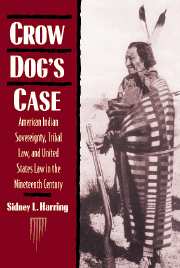 Crow Dog's Case
Crow Dog's Case Book contents
- Frontmatter
- Contents
- Acknowledgments
- 1 “This high pretension of savage sovereignty”
- 2 Corn Tassel: state and federal conflict over tribal sovereignty
- 3 U.S. Indian law and the Indian nations: the Creek Nation, 1870–1900
- 4 Crow Dog's case
- 5 Imposed law and forced assimilation: the legal impact of the Major Crimes Act and the Kagama decision
- 6 Sitting Bull and Clapox: the application of BIA law to Indians outside of the Major Crimes Act
- 7 The struggle for tribal sovereignty in Alaska, 1867–1900
- 8 The legal structuring of violence: U.S. law and the Indian wars
- 9 Conclusion
- Index
9 - Conclusion
Published online by Cambridge University Press: 23 September 2009
- Frontmatter
- Contents
- Acknowledgments
- 1 “This high pretension of savage sovereignty”
- 2 Corn Tassel: state and federal conflict over tribal sovereignty
- 3 U.S. Indian law and the Indian nations: the Creek Nation, 1870–1900
- 4 Crow Dog's case
- 5 Imposed law and forced assimilation: the legal impact of the Major Crimes Act and the Kagama decision
- 6 Sitting Bull and Clapox: the application of BIA law to Indians outside of the Major Crimes Act
- 7 The struggle for tribal sovereignty in Alaska, 1867–1900
- 8 The legal structuring of violence: U.S. law and the Indian wars
- 9 Conclusion
- Index
Summary
No one knows what moved Crow Dog to shoot Spotted Tail on the Dakota prairie. The Brule Sioux even today are divided in their opinions. Spotted Tail is seen by many in the tribe as a heroic figure, a man who kept the tribe together in difficult times in the 1870s, protecting his people's interests. Crow Dog's people still live on the Rosebud Reservation; they are respected traditional leaders still opposed to tribal policies seen as too accommodative of U.S. interests. Crow Dog was among the leaders of the Ghost Dance movement, leading his people north from the Rosebud to the Badlands to await their rebirth. Spotted Tail's people still run the Rosebud Reservation, and Sinte Gleska College, the reservation's community college named after Spotted Tail, is one of the Brule's most vital institutions. A full understanding of the differences between the two men requires an understanding of Brule culture that white Americans simply do not have. Crow Dog's case involves two completely distinct cultural contexts, one the legal culture of the Indian tribes, the other nineteenth-century U.S. legal culture.
Toward an ethnolegal history of Indian law
Only Brule law could penetrate this unknowable world, come to an understanding of Crow Dog's case, and settle it in a way that preserved the integrity of the Brule people. Crow Dog's motives for killing Spotted Tail were intricately bound up in his humanity and cultural identity.
- Type
- Chapter
- Information
- Crow Dog's CaseAmerican Indian Sovereignty, Tribal Law, and United States Law in the Nineteenth Century, pp. 282 - 292Publisher: Cambridge University PressPrint publication year: 1994


